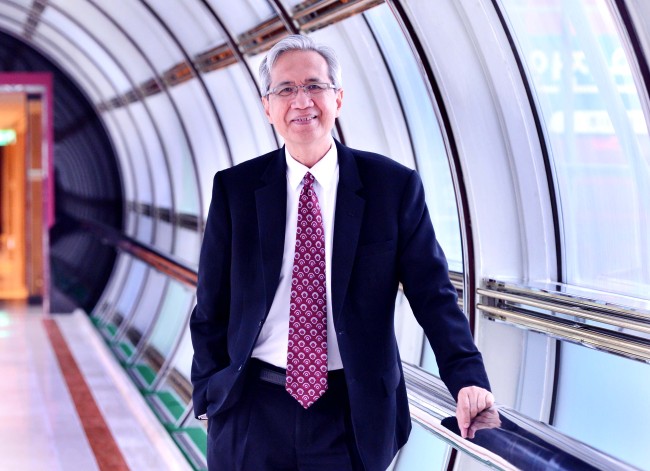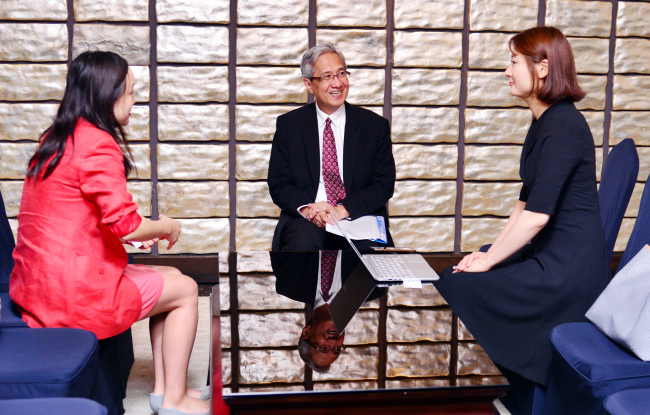[Herald Interview] Young, dynamic and connected -- ASEAN offers endless opportunities for Korea
By Shin Ji-hyePublished : June 22, 2018 - 16:37
Southeast Asia can offer market and business opportunities to South Korea with its young, digitally connected and growing middle class in return for Korea’s sharing of its quickly developed economic strategies, according to a high-ranking official from the Association of Southeast Asian Nations Economic Community.
“Korea will benefit from ASEAN’s dynamism, creativity and growth potential, as the regional production networks are fast expanding,” said Aladdin D. Rillo, deputy secretary-general for the ASEAN Economic Community, in an interview with The Korea Herald after attending a seminar in Seoul for tourism investment between the two regions.
“ASEAN may also benefit from Korea’s long experiences in high-technology manufacturing industry, new technologies and strong focus on sustainable environment,” he added.
Rillo is to serve as deputy secretary-general of the ASEAN Economic Community from 2018 to 2021, providing leadership in the implementation of the AEC Blueprint 2025 and leading the AEC Department of the ASEAN Secretariat. Prior to that, the Philippines native expert, who holds a Ph.D. in economics from the University of Hawaii, worked as a senior economist at the Asian Development Bank Institute in Tokyo. This is the second term for Rillo at the ASEAN secretariat, for which he had served as head of the finance integration division and director and chief economist at the ASEAN Integration Monitoring Office between 2008 and 2013. Rillo has published extensively on the ASEAN economy and macroeconomic and finance issues.
The ASEAN Economic Community, a regional community established in December 2015, envisions ASEAN as a single market and production base with equitable economic development, fully integrated into the global economy.
“Korea will benefit from ASEAN’s dynamism, creativity and growth potential, as the regional production networks are fast expanding,” said Aladdin D. Rillo, deputy secretary-general for the ASEAN Economic Community, in an interview with The Korea Herald after attending a seminar in Seoul for tourism investment between the two regions.
“ASEAN may also benefit from Korea’s long experiences in high-technology manufacturing industry, new technologies and strong focus on sustainable environment,” he added.
Rillo is to serve as deputy secretary-general of the ASEAN Economic Community from 2018 to 2021, providing leadership in the implementation of the AEC Blueprint 2025 and leading the AEC Department of the ASEAN Secretariat. Prior to that, the Philippines native expert, who holds a Ph.D. in economics from the University of Hawaii, worked as a senior economist at the Asian Development Bank Institute in Tokyo. This is the second term for Rillo at the ASEAN secretariat, for which he had served as head of the finance integration division and director and chief economist at the ASEAN Integration Monitoring Office between 2008 and 2013. Rillo has published extensively on the ASEAN economy and macroeconomic and finance issues.
The ASEAN Economic Community, a regional community established in December 2015, envisions ASEAN as a single market and production base with equitable economic development, fully integrated into the global economy.

Growing partnership
ASEAN and Korea’s relations date back to 1989 when they formed a sectoral dialogue partnership. It was further elevated to a full dialogue partnership in 1991. In 2009, the ASEAN-Korea Centre was established as an intergovernmental organization with the aim to promote exchanges among Korea and the 10 ASEAN member states. The organization led by Secretary-General Lee Hyuk implements diverse work programs and activities to increase trade volume, accelerating investment flow, invigorating tourism and enriching cultural and people-to-people exchanges between the two regions.
The relations of the two recently gained momentum when Korean President Moon Jae-in visited Indonesia in November, announcing the nation’s New Southern Policy during a business forum. The policy is aimed at increasing trade volume with ASEAN to $200 billion by 2020, cooperating in the areas of transport, energy, water resources and smart information technology.
“We welcome the priority placed by the President Moon administration’s agenda on ASEAN. This will give a further boost to the good momentum of cooperation between ASEAN and Korea that began way back in 1989,” Rillo said.
Korea is now ASEAN’s fifth-largest trading partner and also its fifth-largest external source of investment. From 2016 to 2017, total bilateral trade between the two economies increased by more than one-fifth to $152 billion. Foreign direct investment flows from Korea to ASEAN were recorded at $5.3 billion in 2017.
“ASEAN can offer more market and business opportunities to Korean companies. The demographic is young, relatively digitally connected and digitally literate. Its middle class is growing and their towns are rapidly urbanizing,” the deputy secretary-general said.
ASEAN member countries marked a combined population of 635 million in 2016, making it the third-largest market in the world. It also has over 100 percent mobile phone penetration and 330 million monthly internet users. The internet economy in its six largest markets -- Indonesia, Malaysia, Philippines, Singapore, Thailand and Vietnam -- is estimated to reach $200 billion by 2025, up from $50 billion in 2017.
At an average of 5.1 percent per year, ASEAN economic growth in the past six years has been greater than global economic growth.

Economic integration
“In ASEAN, each market is small but when we put them together, it will become bigger and more attractive,” Rillo said.
ASEAN is now going through economic integration under the AEC Blueprint 2025 that was adopted by the ASEAN leaders at the 27th ASEAN Summit on Nov. 22, 2015 in Kuala Lumpur, Malaysia.
Its main goal is to integrate the market of $2.6 trillion by 2025. AEC is collectively the third-largest economy in Asia and seventh-largest in the world.
The AEC Blueprint 2025 is aimed toward achieving the vision of having an AEC by 2025 that is highly integrated, cohesive, competitive, innovative and dynamic with enhanced connectivity and sectoral cooperation, according to the plan.
“We are trying to eliminate all the red tape and restriction for free movement of goods, services, finance and people within ASEAN,” he said.
Various moves are now under way to facilitate wider trade.
ASEAN already reduced tariffs to almost zero and it is also reducing nontariff measures such as customs clearance and regulations. It has implemented the ASEAN Single Window, which enables the electronic exchange of border documents among ASEAN member states, eliminating all paperwork.
“Through the moves, ASEAN is working towards reducing trade transaction cost in the region by 10 percent in 2020 and doubling intra-ASEAN trade between 2017 and 2025,” he said.
ASEAN is also moving to open the region to outside countries, implementing the ASEAN Comprehensive Investment Agreement. This allows non-ASEAN investors to more conveniently make investments in Southeast Asia by offering them the same treatment as local investors.
The ASEAN Comprehensive Investment Agreement provides for a four-prolonged approach to turning ASEAN into a preferred investment destination through investment liberalization, promotion, facilitation and protection.
“We are improving ASEAN’s investment regime (to make) a more business-friendly and innovation-supporting regional environment,” he said.
Moving ahead
Moving ahead and along with the continued implementation of the AEC Blueprint 2025, ASEAN is also moving to give recognition to the shifting and fast-changing business environment.
“The advent of the ‘fourth industrial revolution’ and the new technologies that it entails -- ranging from artificial intelligence, robotics, blockchain to internet of the things -- will bring about the transformative changes that affect all aspects of our lives, and which in turn will inform how ASEAN should pursue its agenda,” Rillo said.
ASEAN will also need to recognize and address inherent risks and challenges, such as addressing the digital divide, particularly for those groups adversely affected by the phenomenon, cybersecurity and a lack of advanced infrastructure. The success of the AEC will ultimately be contingent on whether and to what extent it is able to extend opportunities and potential benefits to the broad stakeholders, according to Rillo.
“To achieve this, regional efforts should be done in a participatory and inclusive manner taking into consideration of sustainability and long-term goals of our agenda,” he said.
By Shin Ji-hye (shinjh@heraldcorp.com)









![[Kim Seong-kon] Democracy and the future of South Korea](http://res.heraldm.com/phpwas/restmb_idxmake.php?idx=644&simg=/content/image/2024/04/16/20240416050802_0.jpg&u=)










![[Today’s K-pop] Zico drops snippet of collaboration with Jennie](http://res.heraldm.com/phpwas/restmb_idxmake.php?idx=642&simg=/content/image/2024/04/18/20240418050702_0.jpg&u=)